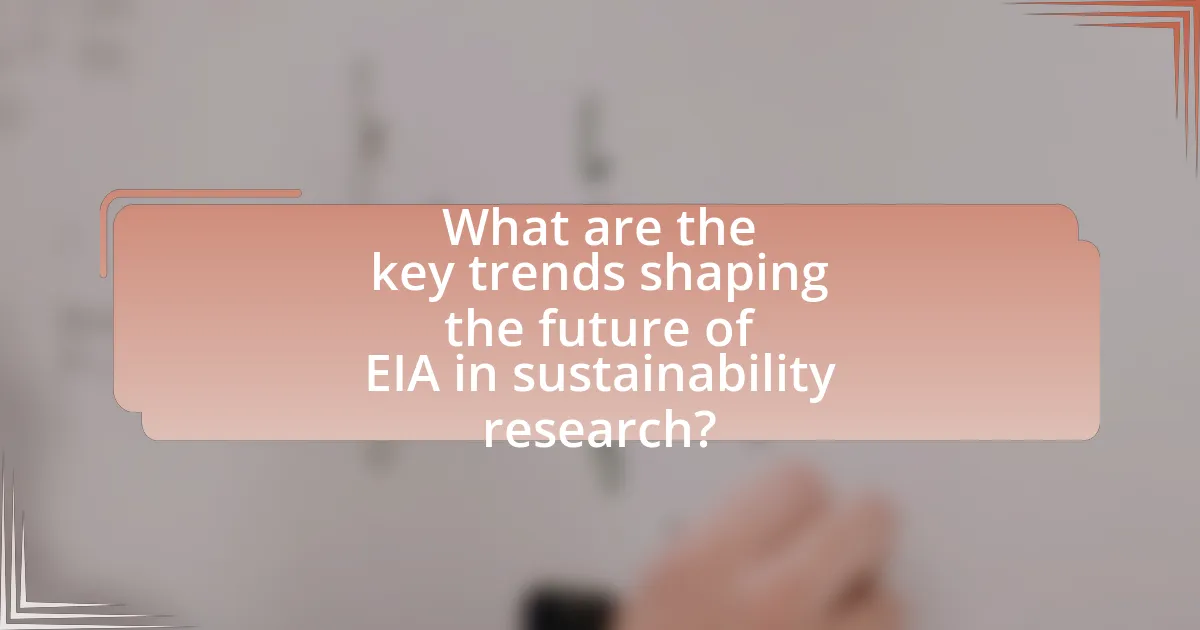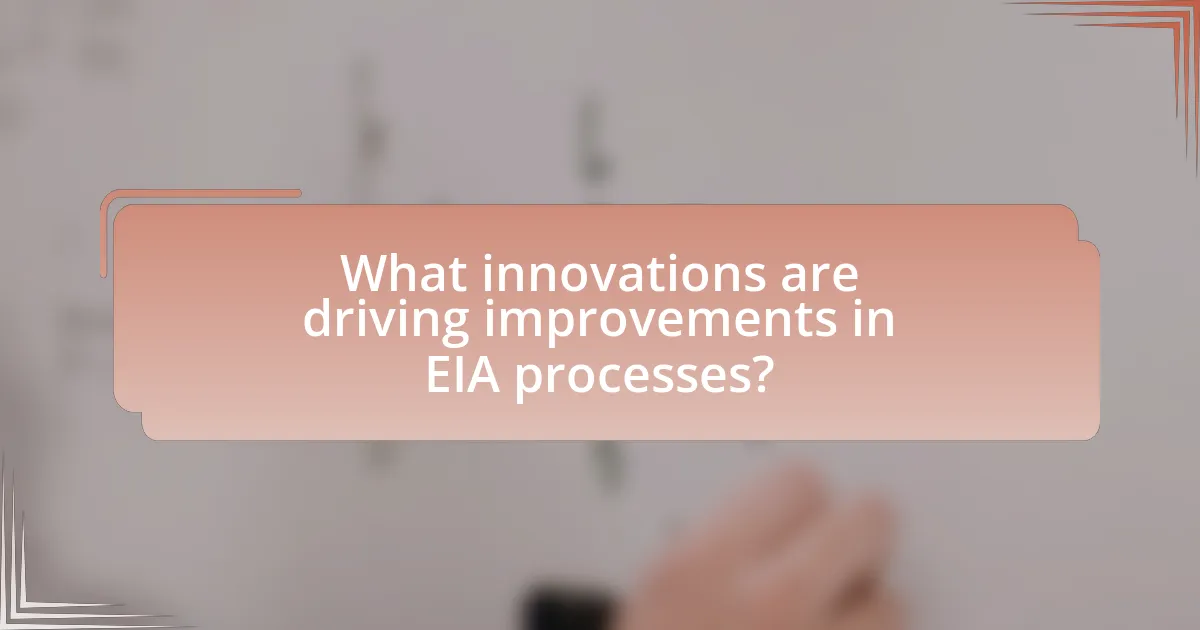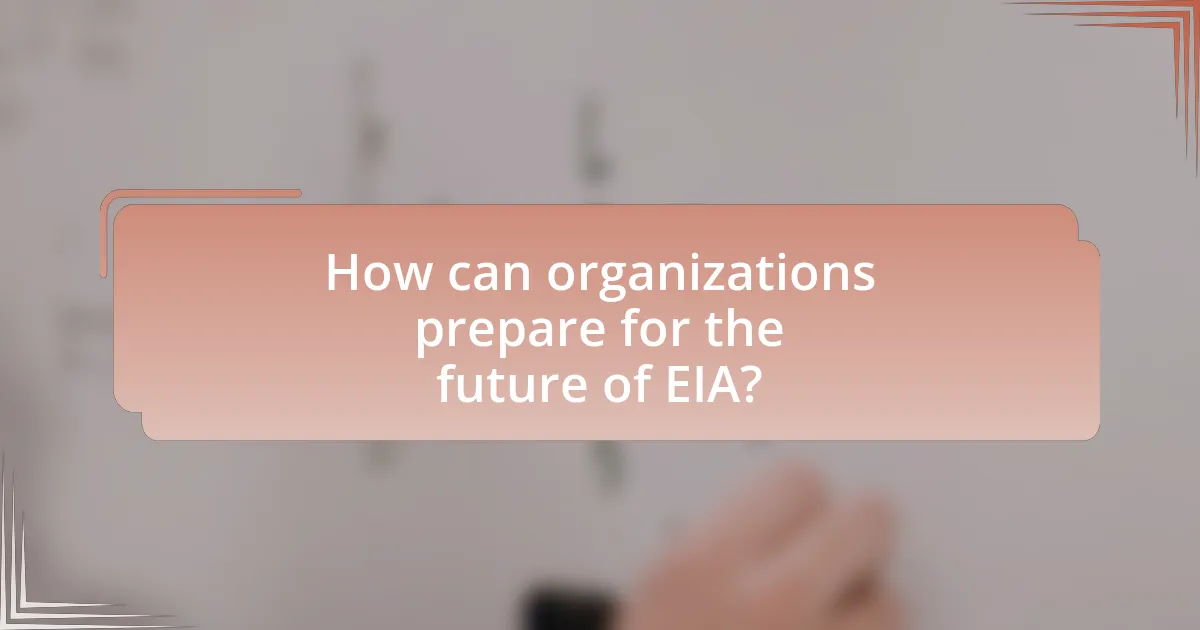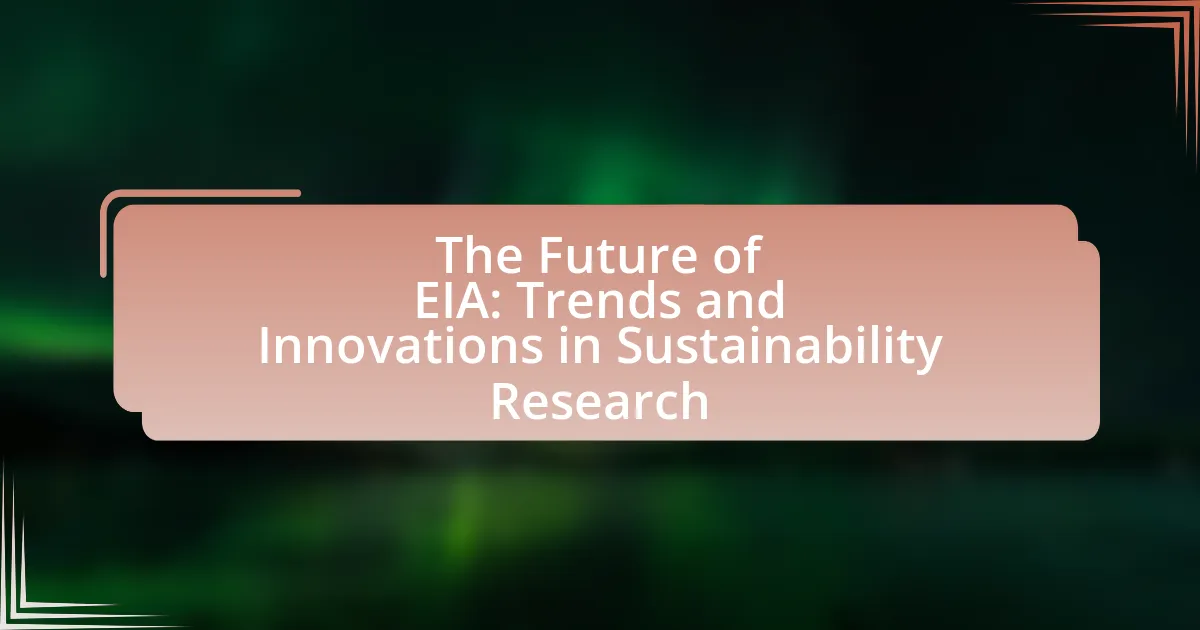The article focuses on the future of Environmental Impact Assessment (EIA) and its evolving role in sustainability research. It highlights key trends such as the integration of advanced technologies, enhanced stakeholder engagement, and a growing emphasis on climate resilience. The discussion includes the influence of data analytics and digital tools on EIA practices, emerging methodologies like participatory approaches, and the significance of adaptive management. Additionally, it examines the impact of new regulatory frameworks and international standards on local EIA practices, as well as the importance of public participation and transparency in decision-making processes. The article concludes with practical strategies for organizations to improve EIA effectiveness and ensure compliance with regulations.

What are the key trends shaping the future of EIA in sustainability research?
Key trends shaping the future of Environmental Impact Assessment (EIA) in sustainability research include the integration of advanced technologies, stakeholder engagement, and a focus on climate resilience. Advanced technologies, such as Geographic Information Systems (GIS) and remote sensing, enhance data collection and analysis, allowing for more accurate assessments of environmental impacts. Stakeholder engagement is increasingly prioritized, ensuring that diverse perspectives are considered in the decision-making process, which aligns with the principles of sustainable development. Additionally, the emphasis on climate resilience reflects a growing recognition of the need to adapt to changing environmental conditions, influencing EIA methodologies to incorporate long-term sustainability goals. These trends are supported by research indicating that effective EIA practices can significantly contribute to sustainable development outcomes, as highlighted in studies by the International Association for Impact Assessment.
How is technology influencing EIA practices?
Technology is significantly influencing Environmental Impact Assessment (EIA) practices by enhancing data collection, analysis, and stakeholder engagement. Advanced tools such as Geographic Information Systems (GIS) and remote sensing allow for more accurate environmental data mapping and monitoring, which improves the assessment process. For instance, GIS technology enables the visualization of environmental impacts over geographical areas, facilitating better decision-making. Additionally, the use of artificial intelligence and machine learning algorithms helps in predicting potential environmental impacts based on historical data, thus streamlining the assessment process. Furthermore, digital platforms enhance stakeholder engagement by providing accessible information and enabling real-time feedback, which fosters transparency and collaboration in EIA processes. These technological advancements lead to more efficient, accurate, and participatory EIA practices, ultimately contributing to better environmental management.
What role do data analytics play in enhancing EIA effectiveness?
Data analytics significantly enhance Environmental Impact Assessment (EIA) effectiveness by providing data-driven insights that improve decision-making processes. By analyzing large datasets, stakeholders can identify potential environmental impacts more accurately and efficiently, leading to better-informed assessments. For instance, predictive modeling techniques can forecast environmental changes based on various development scenarios, allowing for proactive mitigation strategies. Furthermore, data analytics facilitates real-time monitoring of environmental indicators, enabling timely interventions and adaptive management. Studies have shown that integrating data analytics into EIA processes can reduce assessment time by up to 30%, thereby increasing the overall efficiency and effectiveness of environmental evaluations.
How are digital tools transforming stakeholder engagement in EIA?
Digital tools are transforming stakeholder engagement in Environmental Impact Assessment (EIA) by enhancing communication, accessibility, and data visualization. These tools facilitate real-time interaction between stakeholders and project developers, allowing for more inclusive participation in the decision-making process. For instance, platforms like online surveys and social media enable broader outreach, ensuring that diverse community voices are heard. Additionally, Geographic Information Systems (GIS) and interactive mapping tools provide stakeholders with visual representations of potential environmental impacts, making complex data more understandable. Research indicates that projects utilizing digital engagement tools experience higher stakeholder satisfaction and more effective feedback loops, ultimately leading to better-informed environmental decisions.
What emerging methodologies are being adopted in EIA?
Emerging methodologies being adopted in Environmental Impact Assessment (EIA) include the use of Geographic Information Systems (GIS), participatory approaches, and cumulative impact assessment. GIS enhances spatial analysis and visualization, allowing for better decision-making and stakeholder engagement. Participatory approaches involve stakeholders in the assessment process, improving transparency and community involvement. Cumulative impact assessment evaluates the combined effects of multiple projects, addressing the limitations of traditional EIA that often focus on single projects. These methodologies reflect a shift towards more integrated and holistic approaches in sustainability research, aligning with contemporary environmental challenges.
How does participatory EIA contribute to sustainability outcomes?
Participatory Environmental Impact Assessment (EIA) enhances sustainability outcomes by integrating diverse stakeholder perspectives into the decision-making process. This inclusion fosters a more comprehensive understanding of environmental, social, and economic impacts, leading to more informed and balanced project outcomes. Research indicates that projects utilizing participatory EIA often result in improved community acceptance and reduced conflicts, as stakeholders feel their voices are heard and considered. For instance, a study by the International Association for Impact Assessment found that participatory approaches can lead to better environmental management practices and increased project sustainability, as they encourage collaboration and shared responsibility among stakeholders.
What is the significance of adaptive management in EIA processes?
Adaptive management is significant in Environmental Impact Assessment (EIA) processes because it allows for flexible decision-making that can respond to new information and changing environmental conditions. This approach enhances the effectiveness of EIA by integrating ongoing monitoring and feedback mechanisms, which facilitate adjustments to management strategies as projects progress. For instance, studies have shown that adaptive management can lead to improved ecological outcomes by enabling timely interventions based on real-time data, thereby reducing negative impacts on the environment.

What innovations are driving improvements in EIA processes?
Innovations driving improvements in Environmental Impact Assessment (EIA) processes include the integration of advanced data analytics, geographic information systems (GIS), and stakeholder engagement technologies. Advanced data analytics enhances the ability to process large datasets, allowing for more accurate predictions of environmental impacts. Geographic information systems provide spatial analysis capabilities that improve the visualization of potential impacts and facilitate better decision-making. Additionally, stakeholder engagement technologies, such as online platforms for public participation, foster greater transparency and inclusivity in the EIA process. These innovations collectively enhance the efficiency, accuracy, and stakeholder involvement in EIA, leading to more sustainable outcomes.
How are new regulatory frameworks impacting EIA?
New regulatory frameworks are enhancing the effectiveness and transparency of Environmental Impact Assessments (EIA). These frameworks often introduce stricter guidelines and requirements for stakeholder engagement, ensuring that public input is considered in the decision-making process. For instance, the European Union’s revised EIA Directive mandates that member states improve public participation and access to information, which has led to more comprehensive assessments and increased accountability. Additionally, these frameworks often emphasize sustainability and climate resilience, pushing organizations to incorporate long-term environmental considerations into their projects. This shift is evidenced by the growing integration of climate change assessments within EIAs, aligning with global sustainability goals.
What are the implications of international standards on local EIA practices?
International standards significantly influence local Environmental Impact Assessment (EIA) practices by promoting consistency, enhancing credibility, and improving environmental protection measures. These standards, such as those set by the International Organization for Standardization (ISO), provide frameworks that local EIA processes can adopt to ensure thorough assessments and stakeholder engagement. For instance, the ISO 14001 standard emphasizes the importance of systematic environmental management, which local practices can integrate to enhance their effectiveness. Furthermore, adherence to international standards can facilitate cross-border projects by ensuring that local EIA practices meet global expectations, thereby attracting foreign investment and fostering sustainable development.
How do policy changes affect the integration of sustainability in EIA?
Policy changes significantly enhance the integration of sustainability in Environmental Impact Assessments (EIA) by establishing new regulatory frameworks and guidelines that prioritize sustainable practices. For instance, the introduction of policies that mandate the consideration of long-term environmental impacts encourages project developers to adopt sustainable methodologies. Research indicates that countries implementing stringent sustainability policies, such as the European Union’s Environmental Impact Assessment Directive, have seen improved environmental outcomes and greater stakeholder engagement in the EIA process. These policy shifts compel organizations to incorporate sustainability metrics, leading to more comprehensive assessments that align with global sustainability goals.
What role does public participation play in the future of EIA?
Public participation is crucial for the future of Environmental Impact Assessment (EIA) as it enhances transparency, accountability, and community engagement in decision-making processes. Engaging the public allows for diverse perspectives, which can lead to more comprehensive assessments of potential environmental impacts. Research indicates that projects with strong public involvement often result in better environmental outcomes and increased public trust in regulatory processes. For instance, a study by the International Association for Impact Assessment highlights that public participation can improve the quality of EIA reports by incorporating local knowledge and addressing community concerns effectively. Thus, the integration of public participation is essential for advancing EIA practices and fostering sustainable development.
How can technology enhance public involvement in EIA processes?
Technology can enhance public involvement in Environmental Impact Assessment (EIA) processes by facilitating real-time communication and data sharing. Digital platforms, such as online surveys and social media, allow stakeholders to provide feedback and access information easily, increasing transparency and engagement. For instance, the use of Geographic Information Systems (GIS) enables the visualization of project impacts, helping the public understand potential environmental changes. Additionally, mobile applications can notify citizens about upcoming meetings and deadlines, ensuring broader participation. Research indicates that communities utilizing these technologies report higher levels of public engagement and satisfaction with the EIA process, demonstrating the effectiveness of technology in fostering inclusive dialogue.
What are the challenges of ensuring effective public participation in EIA?
Ensuring effective public participation in Environmental Impact Assessment (EIA) faces several challenges, including limited public awareness, inadequate access to information, and the complexity of technical data. Limited public awareness often results in low engagement levels, as many community members may not understand the EIA process or its significance. Inadequate access to information can hinder participation, as stakeholders may lack the necessary resources or platforms to obtain relevant data. Additionally, the complexity of technical data can alienate non-experts, making it difficult for them to contribute meaningfully to discussions. These challenges collectively impede the goal of inclusive and informed public participation in EIA processes.

How can organizations prepare for the future of EIA?
Organizations can prepare for the future of Environmental Impact Assessment (EIA) by adopting advanced technologies, enhancing stakeholder engagement, and integrating sustainability into decision-making processes. The use of data analytics and Geographic Information Systems (GIS) allows organizations to assess environmental impacts more accurately and efficiently. For instance, a study by the World Bank highlights that GIS can improve spatial analysis in EIA, leading to better-informed decisions. Additionally, fostering collaboration with stakeholders, including local communities and regulatory bodies, ensures that diverse perspectives are considered, enhancing the legitimacy and effectiveness of the EIA process. Furthermore, integrating sustainability principles into organizational strategies aligns with global trends towards sustainable development, as evidenced by the United Nations’ Sustainable Development Goals, which emphasize the importance of environmental considerations in all sectors.
What best practices should organizations adopt for effective EIA?
Organizations should adopt a systematic approach to Environmental Impact Assessment (EIA) that includes stakeholder engagement, comprehensive data collection, and adherence to regulatory frameworks. Engaging stakeholders early in the process ensures that diverse perspectives are considered, which enhances the quality and acceptance of the EIA outcomes. Comprehensive data collection, including baseline environmental conditions and potential impacts, is crucial for informed decision-making. Adhering to regulatory frameworks ensures compliance with legal requirements and promotes transparency. Research indicates that organizations that implement these best practices are more likely to achieve successful project outcomes and minimize negative environmental impacts, as evidenced by case studies demonstrating improved project sustainability and community relations.
How can organizations leverage stakeholder feedback in EIA?
Organizations can leverage stakeholder feedback in Environmental Impact Assessment (EIA) by systematically integrating it into decision-making processes. This integration allows organizations to identify potential environmental concerns, enhance project design, and foster community support. For instance, studies show that incorporating stakeholder input can lead to more sustainable outcomes, as evidenced by the 2018 research published in the Journal of Environmental Management, which found that projects with active stakeholder engagement had a 30% higher success rate in meeting environmental goals. By utilizing feedback mechanisms such as surveys, public meetings, and focus groups, organizations can ensure that diverse perspectives are considered, ultimately leading to more informed and effective EIA practices.
What strategies can enhance the transparency of EIA processes?
Enhancing the transparency of Environmental Impact Assessment (EIA) processes can be achieved through several key strategies. First, increasing public participation by involving stakeholders early in the EIA process ensures diverse perspectives are considered, which has been shown to improve decision-making quality. For instance, the International Association for Impact Assessment emphasizes that stakeholder engagement leads to more comprehensive assessments and greater public trust.
Second, implementing clear communication channels and accessible information platforms allows stakeholders to easily access EIA documents and updates. Research by the World Bank indicates that transparency in information dissemination correlates with improved project outcomes and community support.
Third, utilizing technology such as online platforms for real-time updates and feedback mechanisms can facilitate ongoing dialogue between project proponents and the public. A study published in the Journal of Environmental Management found that digital tools enhance stakeholder engagement and transparency in EIA processes.
Lastly, establishing independent review bodies to oversee EIA processes can provide an additional layer of accountability, ensuring that assessments are conducted impartially and transparently. The effectiveness of independent reviews has been documented in various case studies, demonstrating their role in enhancing public confidence in EIA outcomes.
What are the common pitfalls to avoid in EIA implementation?
Common pitfalls to avoid in Environmental Impact Assessment (EIA) implementation include inadequate stakeholder engagement, insufficient data collection, and failure to integrate findings into decision-making processes. Inadequate stakeholder engagement can lead to a lack of community support and oversight, which is critical for the success of EIA projects. Insufficient data collection often results in incomplete assessments, undermining the reliability of the EIA outcomes. Additionally, failing to integrate EIA findings into the decision-making process can render the assessment ineffective, as decision-makers may overlook crucial environmental considerations. These pitfalls have been documented in various studies, highlighting their impact on the overall effectiveness of EIA practices.
How can organizations ensure compliance with EIA regulations?
Organizations can ensure compliance with Environmental Impact Assessment (EIA) regulations by implementing a systematic approach that includes thorough assessments, stakeholder engagement, and adherence to legal frameworks. This involves conducting comprehensive environmental assessments prior to project initiation, which helps identify potential impacts and mitigation measures. Engaging stakeholders, including local communities and regulatory bodies, fosters transparency and accountability, ensuring that all concerns are addressed. Furthermore, organizations must stay updated on relevant legislation and guidelines, as EIA regulations can vary by jurisdiction and may evolve over time. Regular training for staff on compliance requirements and best practices also enhances adherence to EIA regulations, ultimately leading to sustainable project outcomes.
What steps can be taken to mitigate risks associated with EIA failures?
To mitigate risks associated with Environmental Impact Assessment (EIA) failures, implementing comprehensive stakeholder engagement is essential. Engaging stakeholders throughout the EIA process ensures that diverse perspectives are considered, which can lead to more informed decision-making and identification of potential issues early on. Additionally, enhancing the quality of data collection and analysis improves the reliability of EIA outcomes. For instance, utilizing advanced modeling techniques and geographic information systems (GIS) can provide more accurate predictions of environmental impacts. Furthermore, establishing clear regulatory frameworks and guidelines helps standardize EIA practices, reducing variability and enhancing accountability. Evidence from various case studies indicates that jurisdictions with robust stakeholder involvement and stringent regulatory measures experience fewer EIA failures, thereby reinforcing the importance of these steps in risk mitigation.
What practical tips can enhance the effectiveness of EIA in sustainability research?
To enhance the effectiveness of Environmental Impact Assessment (EIA) in sustainability research, integrating stakeholder engagement is crucial. Engaging stakeholders throughout the EIA process ensures diverse perspectives are considered, leading to more comprehensive assessments. Research indicates that projects with active stakeholder involvement often yield better environmental outcomes, as seen in the case of the 2015 EIA for the Trans Mountain Pipeline Expansion, which involved extensive public consultations that shaped the final decision-making process. Additionally, utilizing advanced data analytics can improve the accuracy of impact predictions, as demonstrated by studies showing that predictive modeling enhances the reliability of EIA outcomes. Implementing adaptive management strategies also allows for ongoing adjustments based on monitoring results, thereby increasing the resilience of sustainability initiatives.


